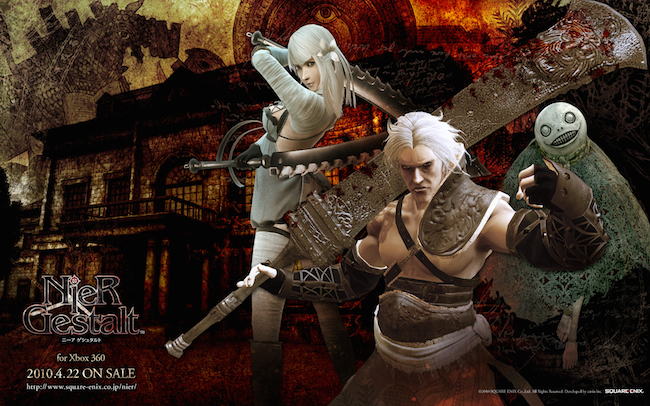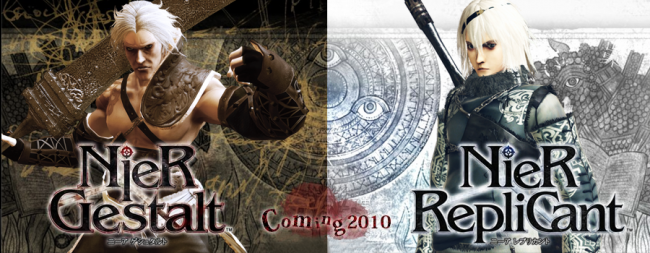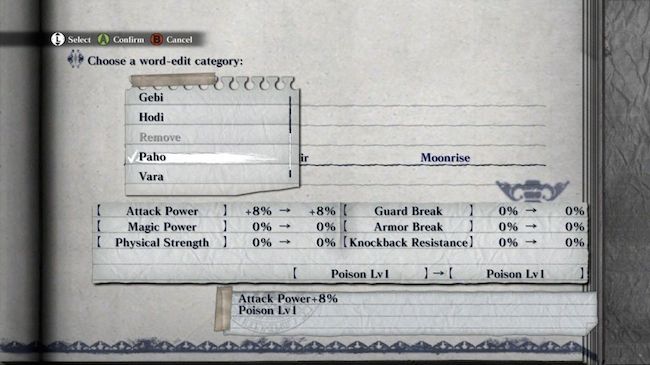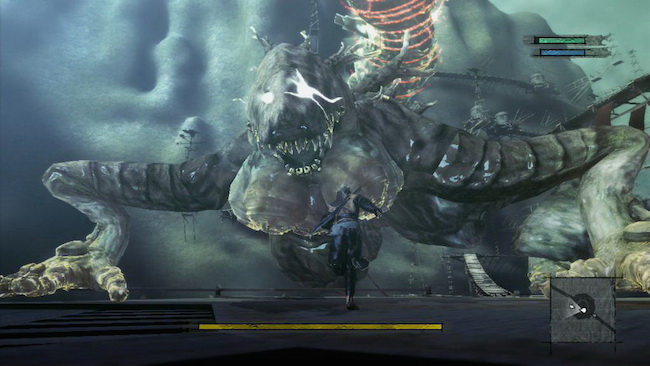
You’ve probably heard about NieR at some point, either from its incredible soundtrack or via a “Top 10 Most Underrated Games” list. The game was originally released in 2010 on PS3 and Xbox 360, but was mostly met with mixed reviews from critics. It was a difficult time for Japanese developers then as many studios struggled with the transition to HD. This meant, like with many other “mediocre” reviewed JRPGs at the time, that NieR would slip from the eye of the mainstream as quickly as it’d arrived. Fortunately, however, the game managed to stay alive due to its music, which I’ve seen pop up regularly over the past couple of years. As a dedicated fan of the genre, as well as gaming music, curiosity lead to an online purchase in 2012, but it would still be several years until I finally played it.

For those unaware, NieR is actually a spiritual successor to the Drakengard series; although, no prior knowledge is required to understand the game. The premise is very straightforward: Nier has a sick daughter called Yonah, who has been infected with a terminal disease known as the black scrawl. Above all else, he wants his daughter to get better and travels the world in search of a cure with a magical talking book called Grimoire Weiss, as well as two other unlikely companions, Kainé and Emil. However, the bigger complication is that the world is in a post-apocalyptic state as the disease has wiped out most of civilisation, and there is an increase in aggression from creatures known as Shades, the primary enemies in the game, who stalk the world and further diminish any hope for humanity’s recovery.
Initially, two versions of the game were released in Japan: NieR Gestalt for 360 and NieR Replicant for PS3. The only difference between these versions, however, is that the main character is much younger in Replicant, and changed to be the brother of Yonah instead of her father. It’s important to clarify that the 360 version (what we received in the west) is the original version; with young Nier being created to appeal to Japanese players who might not relate with his brutish counterpart. It’s important to clarify on this as there was a trend of Japanese developers altering their games to appeal to Westerners at the time, and it became a common misconception that “Father Nier” was such an attempt.

I have to admit, I almost turned the game off after two hours as I just wasn’t feeling it. Wow. What a mistake that would have been! I suspect this may have been the case with other players, and it saddens me to know that many potential players might not have stuck with it. NieR might not be pretty to look at sometimes, which I’ll get to soon, but, seriously, unlike the previous JRPG I reviewed, this ended up being a surprisingly unconventional story given the genre. In fact, the main cast of characters grew to be some of the most memorable from any game I’ve ever played; especially with Kainé, who tackles some incredibly heavy real-world issues. There is a lot of well developed backstory for the entire cast, with none falling into any of the usual stereotypes; everyone was genuinely unique and interesting.
At its core, Nier is a personal story about a man and his dying daughter, and it never ever loses that focus; despite there always being hints towards a much larger picture. You see, the modern era (or our generation, if you prefer) was 1,300 years prior to the current setting, and there are remnants of that world which provide really interesting twists to the plot. In fact, in true JRPG fashion, there are going to be revelations that are both shocking and exciting, and I don’t think the core story will disappoint. It’s very well written. What stands out, though, is a New Game + mode that starts from the mid-point in the game, and provides an alternative perspective on events which will genuinely blow your mind about what you thought was happening. If you give this a go, I can’t emphasise how essential it is to do a second playthrough. It will only take a few hours and is one of the greatest achievements in gaming narrative history.

Nier has a lot of great ideas. The problem, however, is that most are made redundant or were entirely unecessary to begin with. It’s clear the developers had the hopes of creating a big open world with lots of things for the player to do, but the truth is it didn’t need to be. There are a large number of sidequests, but they have no impact on the main game whatsoever, and mostly reward the player with money, which is actually of little value. To be honest, you will only ever need the weapons and items that you organically pick up during play. I see what they were trying to do, but I’m glad it didn’t really work out. The development scope of the game really should have settled somewhere between The Legend of Zelda and Shadow of the Colossus, because if you ignore the afforementioned mechanics, that’s exactly how it plays out: A solid adventure game that allows the player to develop, but never requires any micromanagement.
With that being said, all the mechanics which are essential to the game are both well designed and interesting in practise. The focus of these mechanics are mostly based around your book companion, Grimoire Weiss, and the magical abilities he grants the player. Basically, character growth is limited to experience points and leveling, with the only customisable element in Nier’s arsenal being his weapons and abilities. There are three different weapon types; each of which have their own advantage, and can be interchanged during battle. Likewise, the player can also equip two magical abilities at any given time, and swap around as required. What makes this more interesting, though, is that, during battle, you will collect “words” from downed enemies which can then be equipped through Weiss to provide various perks and advantages. It’s a simple system, but has the power to strongly alter your combat potential.

The combat mechanics would best be described as clunky but satisfying. Basically, everything about the core build design is average, but it never really impedes your ability to enjoy it. As the saying goes: “simplicity is happiness”, and that sums up the combat of NieR in a nutshell. It’s a real-time action battle system with individual buttons assigned to attack, break guard, block, and evade. The only complexity depends on how you mix up the magical abilities, which has a separate gauge that replenishes with time or by attacking red magic orbs. The fuller the gauge is, the more you can charge your magic attacks for greater damage. In truth, there are tactics to it, but unless you put it on hard mode, I suspect most will progress through it without too much difficulty. It’s not remarkable, but it gets the job done just fine.
Sure, some ideas don’t work so well, but the world is still expansive; providing the player with just enough space to evoke a sense of freedom without feeling too empty or overwhelming. It’s also very cool to ride a giant boar when the quick travel system can’t get you close enough to your destination. In addition, there are several quirky ideas which work especially well, such as a farming simulator in Nier’s backyard, and a major segment of the game which literally turns into a text-based adventure. It’s absolutely overflowing with interesting ideas, with each one, successful or not, adding a little bit of charm to the overall adventure. The glory of the gameplay, however, lies in the design of boss fights. I’ve seldom experienced such epic or memorable battles since I first saw Shadows of the Colossus. It takes all the focus off the mechanics, and makes what could have been a narrative-reliant game, memorable to play, as well.

Oh, boy. Without a doubt, this is the area of the game which got slammed the most by critics back in 2010. Well, graphically speaking, at least. Looking back in hindsight, though, without any sort of visual lust or prejudice, I didn’t really find it to be as much of a problem as it clearly was at the time, but there is no denying the lack of detail throughout. I’ve not personally seen the hills in Japan with my own eyes, but I highly doubt they resemble random globs of mashed potato covered in grass, which is an honest description for some of the sceneries. Basically, it’s missing a major coat of polish, but if you can look past its ugly face, the game has interesting visual design in other areas, and a large variety of locations for players to experience. It also has a solid frame-rate, which is always nice.
NieR arguably has one of the greatest game soundtracks ever composed, and I know I’m not the only one who thinks this. This isn’t a newly formed opinion, either. I’ve been hearing music from NieR pop-up online fairly often over the years, so by the time I actually played the game, there were already many tracks I was familiar with. They’re mostly melancholy acoustic pieces, but they all have fantastic melodies that never fail to portray the emotion or tone of adventure when combined on screen. It’s worth an individual purchase, but you can check it out on youtube if you’re curious. Additionally, the game also has a fantastic voice cast which all deliver an inspired performance without falling into the pitfalls of most Japanese to English dubs. Again, Kainé is the most memorable as she has one hell of an attitude and isn’t afraid to drop a few “F-Bombs”; providing an interesting balance to an already audibly diverse cast.
NieR is a prime example of a game that tried to be more than it needed to be. On the surface, the game has a face that only a mother could love, but in its awkward appearance, there’s a visual diversity that keeps the experience interesting and a voice that you won’t ever forget. It might fail as an RPG, but at its core, it undoubtedly succeeds as an adventure game; you just need to be willing to step around some junk to get the most out of it. Above all else, though, playing NieR is about the story. The cast of characters is unique and diverse, with one character in particular who is used to raise awareness for some heavy real world issues. Nier himself is a great protagonist, who, despite all of the epic boss battles and narrative twists, never loses perspective on his own motivations. It’s an unconventional tale for a JRPG that will certainly surprise, and utilises a unique new game plus mode which portrays an alternative perspective on events that will blow your mind. You must play it at least twice to see its genius. It’s absolutely worth it!











